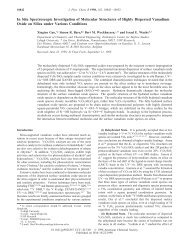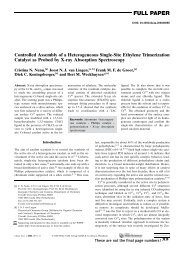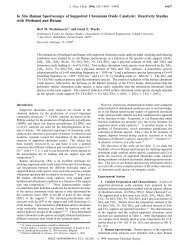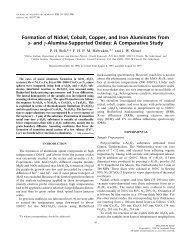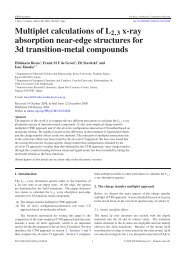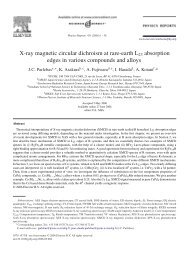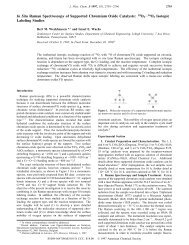Multiplet Effects in X-ray Absorption - Inorganic Chemistry and ...
Multiplet Effects in X-ray Absorption - Inorganic Chemistry and ...
Multiplet Effects in X-ray Absorption - Inorganic Chemistry and ...
Create successful ePaper yourself
Turn your PDF publications into a flip-book with our unique Google optimized e-Paper software.
54 F. de Groot / Coord<strong>in</strong>ation <strong>Chemistry</strong> Reviews 249 (2005) 31–632.4. X-<strong>ray</strong> emissionX-<strong>ray</strong> emission is an old characterization technique. Ittraditionally made use of 1s2p X-<strong>ray</strong> emission <strong>and</strong> 1s3pX-<strong>ray</strong> emission channels, known as K <strong>and</strong> K l<strong>in</strong>es. Onecan divide the X-<strong>ray</strong> emission spectra <strong>in</strong>to the hard X-<strong>ray</strong>spectra decay<strong>in</strong>g to the 1s core hole <strong>and</strong> <strong>in</strong>to soft X-<strong>ray</strong>spectra decay<strong>in</strong>g <strong>in</strong>to the 2p <strong>and</strong> other shallow core states.we will briefly mention a few aspects of such experiments.2.4.1. 1s X-<strong>ray</strong> emissionExcit<strong>in</strong>g a 1s core electron off-resonance creates a 1score hole with a 1s 1 3d 8 ε+1s 1 3d 9 L¯ε configuration. The1s2pX-<strong>ray</strong> emission replaces the 1s core hole with a 2p core hole,hence the f<strong>in</strong>al state can be written as 2p 5 3d 8 ε P +2p 5 3d 9 L¯ε P .This f<strong>in</strong>al state is equivalent to the f<strong>in</strong>al state <strong>in</strong> 2p XPS. Inother words, one measures the same f<strong>in</strong>al states <strong>in</strong>directly via1s XPS followed by 1s2p XES. It should be noted that thespectral shapes of 1s2p XES is not the same as from 2p XPSbecause the transition matrices are different. In addition, the1s core state could undergo ‘relaxation’ effects before the 2pto 1s decay occurs. Many details regard<strong>in</strong>g such relaxationphenomena are still unknown.Similar observations can be made for the 3p <strong>and</strong> valencestates, as is <strong>in</strong>dicated <strong>in</strong> Table 14. In this table CO st<strong>and</strong>sfor cross-over X-<strong>ray</strong> emission, i.e. the cross-over transitionfrom a lig<strong>and</strong> 2s state to a metal 1s state, via the hybridizationof the lig<strong>and</strong> 2s state with the metal 4p state. Bergmannet al. [47] have studied crossover transitions <strong>in</strong> detail. Valenceb<strong>and</strong> X-<strong>ray</strong> emission reaches the same f<strong>in</strong>al states asvalence b<strong>and</strong> photoemission, but aga<strong>in</strong> the matrix elementsare different, <strong>and</strong> the dom<strong>in</strong>at<strong>in</strong>g fluorescent decay channelis the valence b<strong>and</strong> 4p to 1s decay. Because the 4p-charcateris strongly hybridized with the lig<strong>and</strong> valence states, one oftenapparently probes more the lig<strong>and</strong> states than the metalstates.Fig. 22. Resonant XES spectra as a function of the energy difference ofthe <strong>in</strong>cident <strong>and</strong> scattered photon energy (A). Together with the 2p XAS(B), the resonant XES spectra are given for three different excitationenergies (a), (b) <strong>and</strong> (c) (repr<strong>in</strong>ted with permission from [50], copyright1998 American Physical Society).Resonant excitations to the 1s XAS pre-edge modify thedescription of the X-<strong>ray</strong> emission channels considerable.The pre-edge peaks scan is dom<strong>in</strong>ated by the 1s to 3dquadrupole transitions [48]. This implies that the process isself-screened <strong>and</strong> the order<strong>in</strong>g of charge transfer states doesnot change. Perform<strong>in</strong>g 1s2p or 1s3p X-<strong>ray</strong> emission experimentsat the pre-edge creates exactly the same f<strong>in</strong>al states asobserved <strong>in</strong> a direct 2p, respectively, 3p XAS experiments.The transition matrix elements will be different, so the spectralshapes will look different. In fact, the spectral shapeswill be different for each excitation energy. Fig. 22 showsthe spectral shapes of Fe 2 O 3 , compar<strong>in</strong>g the 1s2p pre-edgeexcited states (at two different energies <strong>in</strong> the pre-edge) comparedwith the direct 2p XAS spectrum. In general, it willbe much easier to measure the 2p XAS spectrum, but theTable 14The configurations <strong>in</strong> resonant X-<strong>ray</strong> emission processes follow<strong>in</strong>g, respectively, a 1s XPS, 1s XAS, a 2p XPS <strong>and</strong> a 2p XAS processIntermediate state F<strong>in</strong>al state F<strong>in</strong>al state configurations Related spectroscopy1s XPS 2p 2p 5 3d 8 ε P + 2p 5 3d 9 L¯ε P K (∼2p XPS)1s 1 3d 8 ε P + 1s 1 3d 9 L¯ε P 3p 3p 5 3d 8 ε P + 3p 5 3d 9 L¯ε P K (∼3p XPS)CO L2s 1 3d 8 ε P + L2s 1 3d 9 L¯ε P Cross-over (via 4p)VB L2p 5 3d 8 ε P + L2p 5 3d 9 L¯ε P VB photoemission (via 4p)1s XAS pre-edge 2p 2p 5 3d 9 + 2p 5 3d 10 L¯Resonant K (∼2p XAS)1s 1 3d 9 + 1s 1 3d 10 L¯3p3p 5 3d 9 + 3p 5 3d 10 L¯Resonant K (∼3p XAS)COL2s 1 3d 9 + L2s 1 3d 10 L¯Lig<strong>and</strong> 2s XAS cross-overVBL2p 5 3d 9 + L2p 5 3d 10 L¯Lig<strong>and</strong> 2p VB XAS2p XPS 3d 3d 7 ε P + 3d 8 L¯ε p VB photoemission2p 5 3d 9 L¯ε P 3s 3s 1 3d 8 ε P + 3s 1 3d 9 L¯ε P 3s XPS2p XAS 3d 3d 8 + 3d 9 L¯Ground state + excitations3s3s 1 3d 9 + 3s 1 3d 10 L¯3s XASThe second column gives the f<strong>in</strong>al state core holes.



